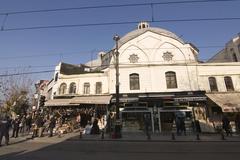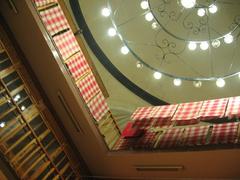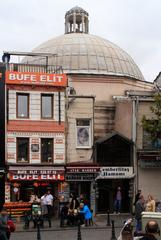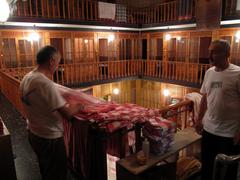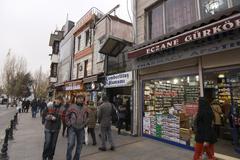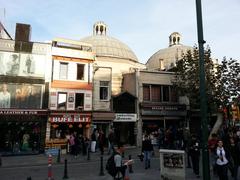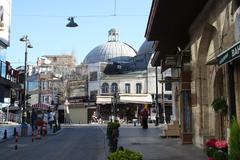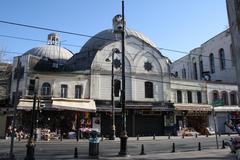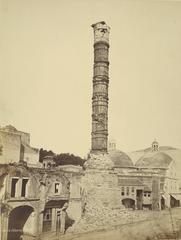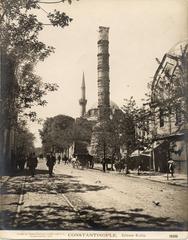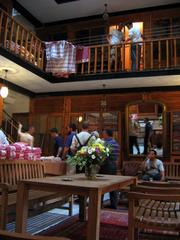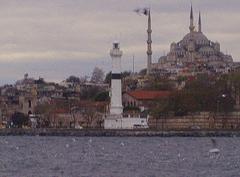
Visiting Hours, Tickets, and Historical Sites of Çemberlitaş, Istanbul
Date: 18/07/2024
Introduction
Çemberlitaş, meaning “Hooped Column” in Turkish, is a historic landmark in the heart of Istanbul that stands as a testament to the city’s rich and multi-layered past. Erected in 330 CE by Roman Emperor Constantine the Great, this monumental column was originally a centerpiece in the Forum of Constantine, marking the declaration of Constantinople (now Istanbul) as the new capital of the Roman Empire (source). Over centuries, it has witnessed the rise and fall of empires, enduring natural disasters and human conflict, yet remaining a steadfast symbol of Istanbul’s resilience and historical significance. With its transformation under the Ottoman Empire, notably the addition of iron hoops by Sultan Mehmed II, Çemberlitaş reflects the architectural prowess of both Byzantine and Ottoman eras and serves as a cultural and historical anchor in modern Istanbul (source). This guide provides an in-depth look into the historical, cultural, and architectural marvels of Çemberlitaş, as well as practical information for visitors aiming to immerse themselves in the historical tapestry that this iconic monument represents.
Table of Contents
- Introduction
- Historical Significance of Çemberlitaş
- Architectural Features and Landmarks of Çemberlitaş
- Visiting Çemberlitaş Today
- Special Events and Guided Tours
- Photographic Spots
- FAQ
- Conclusion
Historical Significance of Çemberlitaş
The Byzantine Legacy: A Column’s Tale
The story of Çemberlitaş begins with Roman Emperor Constantine the Great, who dedicated a monumental forum in Constantinople (now Istanbul) in 330 CE. This forum, known as the Forum of Constantine, was intended to be the heart of the new capital of the Roman Empire. At the center of this grand plaza stood a towering porphyry column, brought from Egypt, and crowned with a bronze statue of the emperor in the guise of Apollo. Over the centuries, the column, known as the Column of Constantine, endured earthquakes, fires, and the ravages of time. The bronze statue atop fell in 1106, replaced later by a cross after the Latin conquest of Constantinople. The Fourth Crusade in 1204 saw further damage and looting, leaving the column scarred and vulnerable.
The Ottoman Era: A Symbol of Conquest and Transformation
When Sultan Mehmed II, known as Mehmed the Conqueror, claimed Constantinople for the Ottoman Empire in 1453, the city underwent a dramatic transformation. The Column of Constantine, though damaged, remained standing. Recognizing its historical significance, Mehmed II ordered its preservation. To reinforce the earthquake-weakened structure, he commissioned the addition of the iron hoops that give Çemberlitaş its present-day name. These hoops, forged from iron, were heated and then fitted around the column, contracting as they cooled to provide robust support.
Çemberlitaş: A Witness to History
Çemberlitaş stands today as a silent observer to centuries of Istanbul’s tumultuous past. It has witnessed the rise and fall of empires and the city’s evolution from a Byzantine center to a thriving Ottoman metropolis. Located at the intersection of major thoroughfares in the heart of Istanbul, it serves as a historical anchor, reminding visitors of the city’s layered past where Roman, Byzantine, and Ottoman influences intertwine.
Architectural Features and Landmarks of Çemberlitaş
The Column of Constantine
No exploration of the area would be complete without acknowledging the Column of Constantine. Erected in 330 CE by Constantine the Great to commemorate the declaration of Constantinople as the new capital of the Roman Empire, the column has borne witness to centuries of change and upheaval. Today, it stands as a silent sentinel, its weathered surface whispering tales of empires past.
The Çemberlitaş Hamam: A Masterpiece of Ottoman Architecture
At the heart of Çemberlitaş stands the Çemberlitaş Hamam, a testament to the architectural genius of the Ottoman era. Built in 1584 by the renowned architect Mimar Sinan, it exemplifies the grandeur and sophistication of Ottoman bathhouse design.
The Exterior: A Glimpse of Grandeur
Visitors are greeted by the hamam’s imposing exterior, characterized by its massive dome, a hallmark of Ottoman architecture. The dome, punctuated by small, round windows, allows natural light to flood the interior. The exterior walls, constructed from alternating courses of brick and white marble, showcase the intricate craftsmanship of the period and help regulate the temperature inside the hamam.
Stepping Inside: A Journey Through Ritual and Relaxation
The entrance to the Çemberlitaş Hamam is an experience in itself. A monumental doorway leads into a cool, shadowy vestibule known as the camekan, serving as a place for bathers to prepare for their bath and socialize. The centerpiece of the camekan is a large, octagonal fountain. From the camekan, bathers proceed to the soğukluk or cold room, designed for relaxation and socializing, followed by the ılıklık or warm room, allowing bathers to acclimate to the heat of the hararet or hot room. The hararet is dominated by a large, heated marble platform known as the göbek taşı (belly stone), where bathers lie to allow the heat to penetrate their muscles and open their pores.
Architectural Significance: A Synthesis of Form and Function
The Çemberlitaş Hamam is a testament to the Ottoman Empire’s mastery of engineering and design. Mimar Sinan, the architect, was renowned for his ability to create buildings that were both aesthetically pleasing and functionally sound. The hamam’s ingenious heating system circulated hot air beneath the floor and through the walls of the hararet, maintaining a constant and comfortable temperature. The numerous domes and skylights provided natural light and ventilation.
Visiting Çemberlitaş Today
Visiting Hours
Çemberlitaş is accessible to the public 24 hours a day, but it is recommended to visit during daylight hours for the best experience.
Tickets
There is no admission fee to visit Çemberlitaş, making it an excellent addition to any itinerary without additional cost.
Nearby Attractions
While visiting Çemberlitaş, consider exploring other nearby historical sites such as the Hagia Sophia, the Blue Mosque, and the Grand Bazaar. Each of these attractions offers a unique glimpse into Istanbul’s rich history and cultural heritage.
Accessibility
Çemberlitaş is located in a bustling area of Istanbul, making it easily accessible by public transportation. The nearest tram stop is Çemberlitaş station, just a short walk away from the column.
Special Events and Guided Tours
Several guided tours of Istanbul include Çemberlitaş in their itinerary, offering in-depth historical insights. These tours are highly recommended for those interested in learning more about the city’s past.
Photographic Spots
For the best photographs, visit Çemberlitaş during the early morning or late afternoon when the light is optimal. The surrounding square also offers various vantage points to capture the column from different angles.
FAQ
Q: What is the height of Çemberlitaş? A: The column is estimated to be around 35 meters tall.
Q: Is there an admission fee to visit Çemberlitaş? A: No, visiting Çemberlitaş is free of charge.
Q: How do I get to Çemberlitaş? A: The nearest tram stop is Çemberlitaş station, and the column is a short walk from there.
Conclusion
Çemberlitaş stands as a tangible connection to Istanbul’s rich and complex past. Whether you are a history enthusiast or a casual visitor, this iconic landmark offers a glimpse into the city’s storied history. Take the time to explore, reflect, and immerse yourself in the historical tapestry that Çemberlitaş represents.
Call to Action
For more historical insights and travel tips, download the Audiala mobile app. Check out our other related posts and follow us on social media for the latest updates on historical sites and attractions in Istanbul.
